高三英语介词和连词
- 格式:ppt
- 大小:495.50 KB
- 文档页数:93
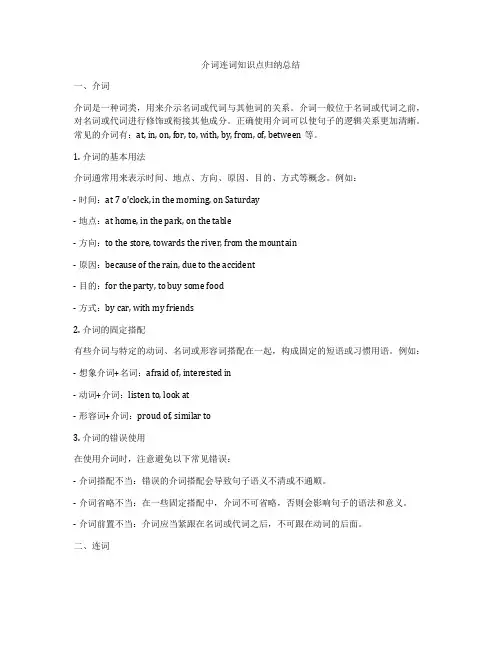
介词连词知识点归纳总结一、介词介词是一种词类,用来介示名词或代词与其他词的关系。
介词一般位于名词或代词之前,对名词或代词进行修饰或衔接其他成分。
正确使用介词可以使句子的逻辑关系更加清晰。
常见的介词有:at, in, on, for, to, with, by, from, of, between等。
1. 介词的基本用法介词通常用来表示时间、地点、方向、原因、目的、方式等概念。
例如:- 时间:at 7 o'clock, in the morning, on Saturday- 地点:at home, in the park, on the table- 方向:to the store, towards the river, from the mountain- 原因:because of the rain, due to the accident- 目的:for the party, to buy some food- 方式:by car, with my friends2. 介词的固定搭配有些介词与特定的动词、名词或形容词搭配在一起,构成固定的短语或习惯用语。
例如:- 想象介词+名词:afraid of, interested in- 动词+介词:listen to, look at- 形容词+介词:proud of, similar to3. 介词的错误使用在使用介词时,注意避免以下常见错误:- 介词搭配不当:错误的介词搭配会导致句子语义不清或不通顺。
- 介词省略不当:在一些固定搭配中,介词不可省略,否则会影响句子的语法和意义。
- 介词前置不当:介词应当紧跟在名词或代词之后,不可跟在动词的后面。
二、连词连词是一种词类,用来连接句子的不同部分,使句子结构更加清晰和连贯。
连词可以连接并列成分,引导从句,表达因果关系等。
常见的连词有:and, but, or, for, yet, so, because, although, while, as等。
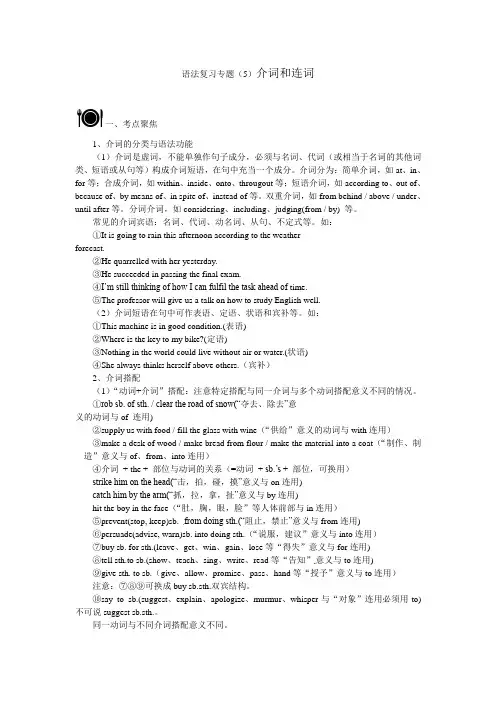
语法复习专题(5)介词和连词一、考点聚焦1、介词的分类与语法功能(1)介词是虚词,不能单独作句子成分,必须与名词、代词(或相当于名词的其他词类、短语或从句等)构成介词短语,在句中充当一个成分。
介词分为:简单介词,如at、in、for等;合成介词,如within、inside、onto、througout等;短语介词,如according to、out of、because of、by means of、in spite of、instead of等。
双重介词,如from behind / above / under、until after等。
分词介词,如considering、including、judging(from / by) 等。
常见的介词宾语:名词、代词、动名词、从句、不定式等。
如:①It is going to rain this afternoon according to the weatherforecast.②He quarrelled with her yesterday.③He succeeded in passing the final exam.④I’m still thinking of how I can fulfil the task ahead of time.⑤The professor will give us a talk on how to study English well.(2)介词短语在句中可作表语、定语、状语和宾补等。
如:①This machine is in good condition.(表语)②Where is the key to my bike?(定语)③Nothing in the world could live without air or water.(状语)④She always thinks herself above others.(宾补)2、介词搭配(1)“动词+介词”搭配:注意特定搭配与同一介词与多个动词搭配意义不同的情况。
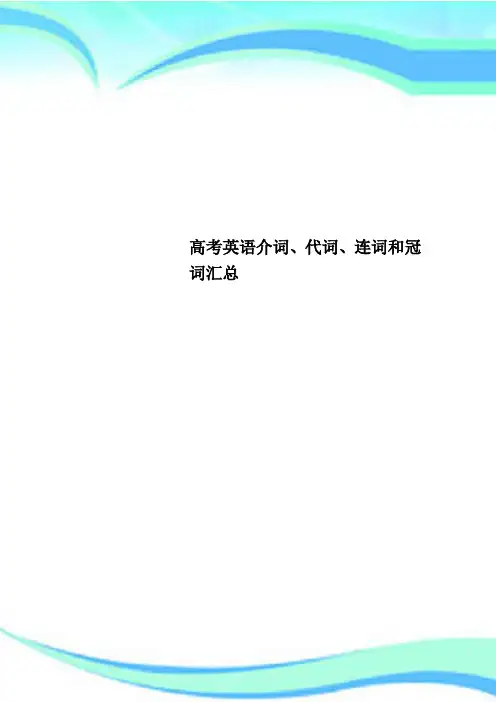
高考英语介词、代词、连词和冠词汇总————————————————————————————————作者:————————————————————————————————日期:高考英语介词、代词、连词和冠词总结一.概念及分类:1.介词:1).时间:in;at;on;by;during;after;before;about;between;over...I swim once a week during winter.I got home at about 9 p.m..2)。
地点:On/to/behind/across/alongHe saw a picture on the wall.Are you going to the post office?3).表其他意思的介词:by/with/due toI usually go to school by bike.I can’t read the book without glasses.2.连词1)。
并列连词:and/both...and/not only...but alsoYou are handsome and strong.She is not only kind but beautiful.2)转折连词:but/however/yet/whileShe is good at swiming while her brother is good at skating. 3)选择连词:or/either...or/otherwiseDo you speak Chinese or English?4)因果连词:because/as/for/since/so/thereforeYou’d better put on your coat for it is rather cold outside.2.从属连词具体知识详见状语从句3.冠词1)定冠词the(这个、那个)表特指看见here /overthere/color 要加定冠词The boy in red is my brother Jay Chow.The girl over there is my girlfriend.我不敢说最高级和序数词前面一定加定冠词。
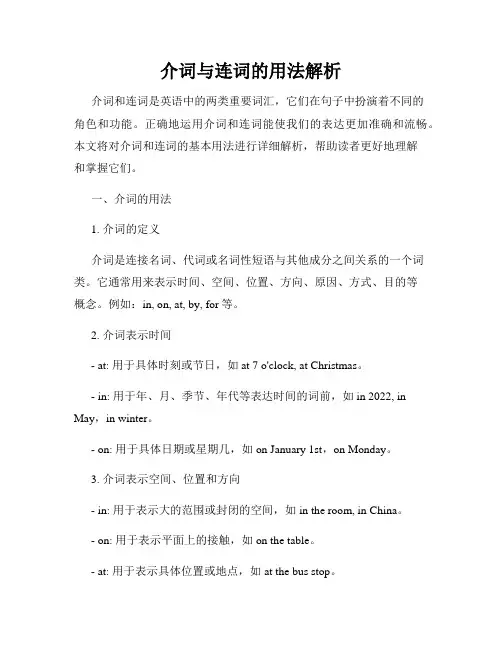
介词与连词的用法解析介词和连词是英语中的两类重要词汇,它们在句子中扮演着不同的角色和功能。
正确地运用介词和连词能使我们的表达更加准确和流畅。
本文将对介词和连词的基本用法进行详细解析,帮助读者更好地理解和掌握它们。
一、介词的用法1. 介词的定义介词是连接名词、代词或名词性短语与其他成分之间关系的一个词类。
它通常用来表示时间、空间、位置、方向、原因、方式、目的等概念。
例如:in, on, at, by, for等。
2. 介词表示时间- at: 用于具体时刻或节日,如at 7 o'clock, at Christmas。
- in: 用于年、月、季节、年代等表达时间的词前,如in 2022, in May,in winter。
- on: 用于具体日期或星期几,如on January 1st,on Monday。
3. 介词表示空间、位置和方向- in: 用于表示大的范围或封闭的空间,如in the room, in China。
- on: 用于表示平面上的接触,如on the table。
- at: 用于表示具体位置或地点,如at the bus stop。
4. 介词表示原因、方式和目的- for: 表示目的或原因,如for fun, for the sake of。
- by: 表示方式、方法或通过某种手段,如by bus, by email。
二、连词的用法1. 连词的定义连词是连接词语、短语或句子的词类。
它用于连接并列成分、并列句、主从句等,起到使句子结构更加完整和连贯的作用。
例如:and, but, or, so等。
2. 并列连词- and: 用于连接同类词、词组和句子,表示并列关系,如I like apples and oranges。
- but: 表示转折或对比关系,如She is smart but lazy。
- or: 表示选择关系,如Do you want tea or coffee?3. 从属连词- because: 引导原因状语从句,如I stayed at home because it was raining。
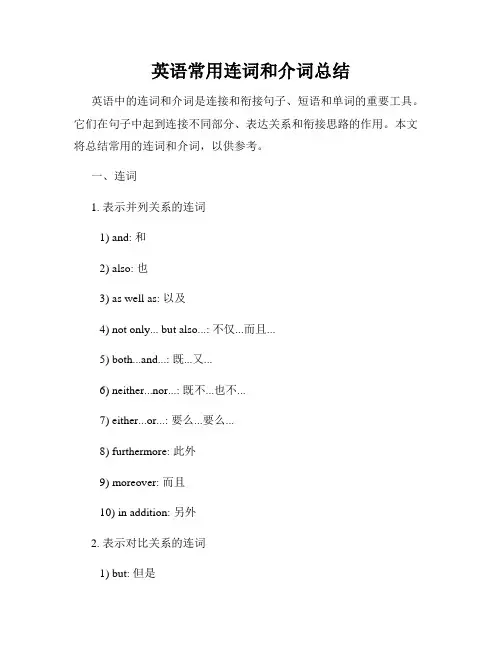
英语常用连词和介词总结英语中的连词和介词是连接和衔接句子、短语和单词的重要工具。
它们在句子中起到连接不同部分、表达关系和衔接思路的作用。
本文将总结常用的连词和介词,以供参考。
一、连词1. 表示并列关系的连词1) and: 和2) also: 也3) as well as: 以及4) not only... but also...: 不仅...而且...5) both...and...: 既...又...6) neither...nor...: 既不...也不...7) either...or...: 要么...要么...8) furthermore: 此外9) moreover: 而且10) in addition: 另外2. 表示对比关系的连词1) but: 但是3) on the other hand: 另一方面4) whereas: 然而5) while: 而3. 表示因果关系的连词1) because: 因为2) since: 既然3) as: 因为4) therefore: 因此5) thus: 因此6) so: 所以4. 表示条件关系的连词1) if: 如果2) unless: 除非3) provided/providing that: 假如/只要5. 表示让步关系的连词1) although: 尽管3) despite: 尽管4) in spite of: 尽管二、介词1. 表示位置关系的介词1) in: 在...内部2) on: 在...上面3) at: 在...旁边4) under: 在...下面5) above: 在...上面6) below: 在...下面7) beside: 在...旁边8) between: 在...之间9) among: 在...之中10) behind: 在...后面11) in front of: 在...前面2. 表示时间关系的介词1) at: 在...时刻2) on: 在...日期3) in: 在...时期3. 表示原因关系的介词1) because of: 因为2) due to: 因为3) owing to: 因为4. 表示方式和手段的介词1) by: 通过2) with: 以...方式3) through: 通过5. 表示目的和用途的介词1) for: 为了2) to: 为了6. 表示例证的介词1) for example: 例如2) such as: 例如7. 表示对比和区分的介词1) like: 像是2) unlike: 不像总结:介词和连词在英语中起到连接和衔接的作用,能够清晰地表达句子之间的关系和思路。
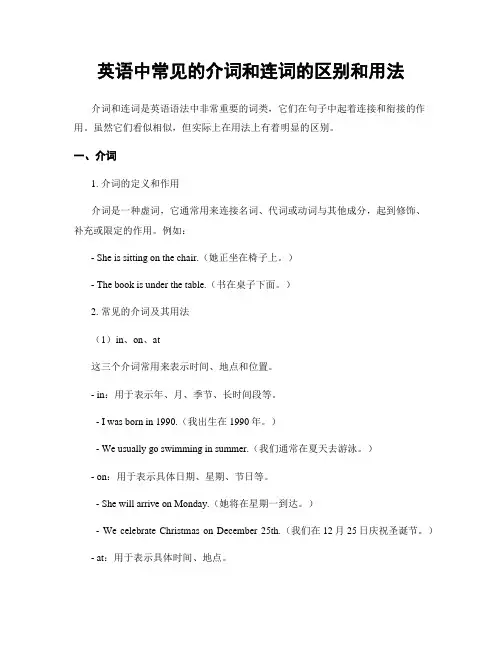
英语中常见的介词和连词的区别和用法介词和连词是英语语法中非常重要的词类,它们在句子中起着连接和衔接的作用。
虽然它们看似相似,但实际上在用法上有着明显的区别。
一、介词1. 介词的定义和作用介词是一种虚词,它通常用来连接名词、代词或动词与其他成分,起到修饰、补充或限定的作用。
例如:- She is sitting on the chair.(她正坐在椅子上。
)- The book is under the table.(书在桌子下面。
)2. 常见的介词及其用法(1)in、on、at这三个介词常用来表示时间、地点和位置。
- in:用于表示年、月、季节、长时间段等。
- I was born in 1990.(我出生在1990年。
)- We usually go swimming in summer.(我们通常在夏天去游泳。
)- on:用于表示具体日期、星期、节日等。
- She will arrive on Monday.(她将在星期一到达。
)- We celebrate Christmas on December 25th.(我们在12月25日庆祝圣诞节。
)- at:用于表示具体时间、地点。
- The meeting will start at 9 o'clock.(会议将在9点开始。
)- I met her at the library.(我在图书馆遇见了她。
)(2)with、without、by这三个介词常用来表示伴随、条件和方式。
- with:表示伴随、附带。
- She went to the party with her friends.(她和她的朋友们一起去了派对。
) - He always carries a book with him.(他总是随身带着一本书。
)- without:表示没有、不带。
- I can't live without you.(没有你我无法生活。
)- Please don't leave without saying goodbye.(请不要离开而不说再见。

介词连词知识点总结归纳一、介词的基本概念介词(Prepositions)是一种词类,它通常用来连接名词、代词、动名词或从句等成分,表示时间、地点、方向、原因、目的等关系。
英语中常见的介词有:on, in, at, to, for, with, by, from, into, out of, between, among, through等。
1. 表示时间关系的介词on:表示某一天、日期、时间点等。
in:表示较长的时间段,季节、年代等。
at:表示具体的时间点、场所、节日等。
例句:I will meet you at the corner of the street at 3 o'clock.I was born in 1990.She always goes to school on foot.2. 表示地点关系的介词in:表示某个大的范围或容器内。
on:表示某个平面或表面上。
at:表示某个具体点或目标。
例句:The book is in the drawer.There is a cat on the roof.She is waiting at the bus stop.3. 表示方向关系的介词to:表示朝着某个目标或方向。
from:表示从某个地点或方向出发。
into:表示朝着某个范围或内部。
例句:He walked to the park.I come from China.She poured the water into the glass.4. 表示原因和目的的介词for:表示给予或用于某种目的。
with:表示陪伴或使用某种手段。
例句:I bought a gift for my friend.She cut the cake with a knife.5. 表示关系的介词between:表示在两者或多者之间的关系。
among:表示在多个之中的关系。
through:表示穿过或通过某个范围。
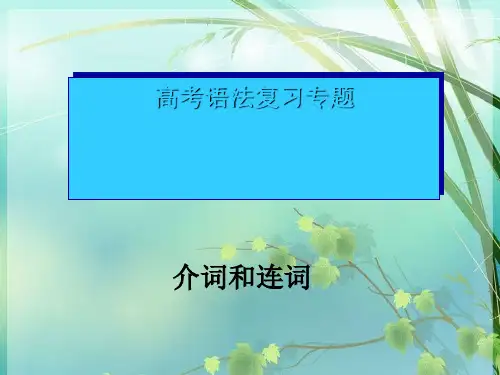
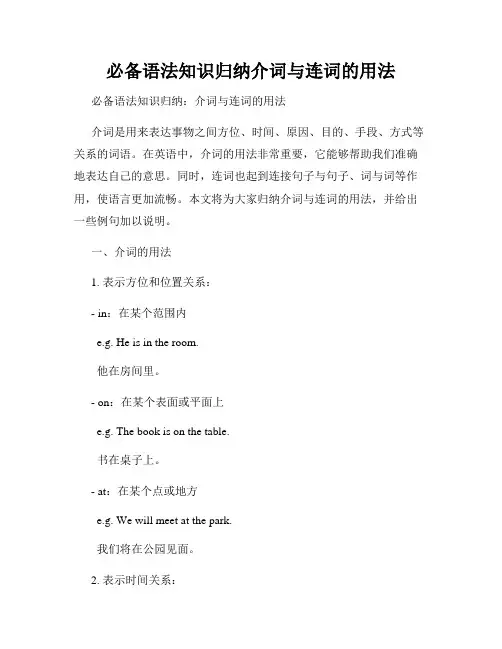
必备语法知识归纳介词与连词的用法必备语法知识归纳:介词与连词的用法介词是用来表达事物之间方位、时间、原因、目的、手段、方式等关系的词语。
在英语中,介词的用法非常重要,它能够帮助我们准确地表达自己的意思。
同时,连词也起到连接句子与句子、词与词等作用,使语言更加流畅。
本文将为大家归纳介词与连词的用法,并给出一些例句加以说明。
一、介词的用法1. 表示方位和位置关系:- in:在某个范围内e.g. He is in the room.他在房间里。
- on:在某个表面或平面上e.g. The book is on the table.书在桌子上。
- at:在某个点或地方e.g. We will meet at the park.我们将在公园见面。
2. 表示时间关系:- at:在某个具体时间点e.g. I will arrive at 8 o'clock.我将在8点钟到达。
- on:在某个具体日期或星期几e.g. My birthday is on February 14th.我的生日是在2月14日。
- in:在某个时间段或年份e.g. I will go on vacation in the summer.我会在夏天去度假。
3. 表示原因、目的、手段和方式:- for:表示目的e.g. I study hard for a better future.我努力学习是为了更好的未来。
- by:表示手段或方法e.g. I sent the letter by mail.我通过邮寄发送了信件。
- with:表示伴随或方式e.g. She walks with confidence.她步履自信地走着。
4. 表示从属或归属关系:- of:表示所属关系e.g. The book is the property of the library.这本书是图书馆的财产。
- to:表示从属关系e.g. He is a loyal servant to the king.他是国王的忠诚仆人。


高三复习语法专项系列----介词和连词一. 介词1. 介词的分类 (在句中作定语, 状语, 补语和表语)单个介词: at , by, for, from, in, of , on , to , with复合介词: into, onto, within, out of双重介词: from under, since before, until after介词短语: in front of, because of, according to分词作介词: including , considering , concerning2. across , through overacross 在一个空间内从一端到另一端或成十字交叉穿过through着重指从中间或空间穿过over 指从一个物体的一边到另一边的越过3. about , on, ofabout表示的内容多为普通,不太正式有”述及”的意思on 多用于慎重的正式的语言交际场合.常见于”学说上的”论文或演说等题目.有论及的意思of 作关于讲, 表示体积,设计某人/事时, 只表示事情存在或发生,并不涉及详情.有时与about可互换 ,常与动词know, hear, learn, speak, talk, think, tell等.但注意区别:talk of / talk about think of/ think about4. except , except for, except that, but , besides, besideexcept 除了---之外都/都不/没有可接名词,代词, 介词短语,副词或不定式 , 不定式常省to.except for 除了,要不是常接名词性短语except that 常接从句,也可接when where 等词引导的从句but 多用在代词(主要是不定代词,否定代词或疑问代词)后besides 除了---之外还有/包括还可用作副词,相当于, 有”而且,加之,何况”的意思.Beside 表示在---附近,5. including , includedincluding 是一个介词, 意思是: 包括, 一般放在包括对象的前面included 是一个过去分词, 用于被动语态中或放在包括对象的后面.6. in, after, laterin 表示一段时间之后, 常用于一般将来时和过去将来时中.after 表某一时刻后, 后跟”时间点”, 常用于一般将来时或一般过去时中;也可表示某一段时间后, 后跟”一段时间”, 用于一般过去时.later 后跟一个具体的时间为起点7. in, with, byin指用”语言,字体,墨水, 体裁, 风格, 方式,现金, 顺序”等.with 指用具体的或有形的工具,器官等, 有时也可表示用某种手段或音调等.by 表示用方式,手段等.后常接动名词,后接就名词时,名词前不加修饰语.8. toward (s) , to , forto 和toward(s)用来表示静态的方向, 可以换用, 但和表示位置转移的动词如: go , come, move, run, return, walk,等连用是, to 有到达之意, 而toward(s) 只表示运动方向, 无到达之意.for 一般用语动词leave , sail, start 及短语set off, set out, start out, start off 等短语后表示方向.9. under/over , below/abovebelow 是on a lower level than 的意思, 表示在下方位置地狱某物. 不强调直上直下, 反义词是above .under 有directly below 的含义, 表示垂直在下方, 反义词是: over.10. 表原因的介词:because of , for, at, by, with, owing to, thanks to, out of 的区别① because of 表示引起结果的直接原因意义与连词because 相同.② for表示内在的, 心理上的饿原因, 常与表示喜怒哀乐等的情感名词连用, 还可表示某种动作或结果的起因. 而连词for 则表示某种结果的补充理由或显而易见的原因.③ at表示外部的, 尤其是暴力的或无意中造成某种结果的原因.④ by表示某种情绪或从做的起因, 多与喜怒哀乐等词连用,有”听到,看到---”⑤ with指胜利上或情感上的外界到内心的原因, 有“随着---”⑥ owing to相当于because of , 多表示某种不良后果的原因. 也有“欠-钱”的意思⑦ thanks to表示引起某种幸运结果的原因, 有“幸亏---, 多亏了---”的意思⑧ 表示动机的起因,常译为“出于---”二. 连词:连词的种类:并列连词: and, or, but, while(然而), for, therefore,both – and---, not only --- but (also)--, as well as, and --- as well,not ---nor--- , whether---or---, either---or--- , neither---nor---,从属连词: (连接状语从句的连词)时间: when , while, as, after, before, since(自从), until, till, as soon as, oncehardly ---when, no sooner ---than , the moment, the minute 地点: where,原因: because, as, since(既然)=now that ,条件: if, even if, unless, as long as=on condition that , in case, supposing, provided that目的:so that , in order that , for fear that, so结果: so ---- that, such ---- that让步: though, although, however + adj. ---, even if, whatever, no matter+ ---,方式: as (象---一样), just as, as if/ though比较: as---as---, the same---as---, so --- as---, the more---, the more---1. because , since, as, for① because表示直接明确的原因或理由,语气最强.② since强调结果, 不强调原因, since 表示自然的因果关系,意为“既然”.③ as也是只强调结果, 不强调原因, 语气最弱, 用于常谈中, 讲话人认为某种理由很明显或对方很熟悉,不需要突出.④ for是并列连词, 只表示一种推测. 其前的分句常是must have done 或must do注意点: 只有表示一种直接的原因或理由, 用它来回答why的疑问句, 也只有可有放在强调句中, 使它成为强调的对象, 而其他的不能.2. if , whether引导条件状语时只用if,作是否的意思时, 注意几种只用whether的情况.3. or , and① 否定句中连接并列成分一般用or② 当一个句子中出现了两个否定词时, 或两个并列成分都有否定时, 用and 连接, 表示的是全部否定.③ A nd 连接的两个主语表示的是两者以上的人物时, 谓语用复数,而 or连接时, 谓语则要与邻近的主语一致.4. such as, for example, and so on , namely① such as 列举部分, 可以是一个也可以是多个② for example列举单个人或事物外,还可列举一个完整的事件或一系列人物. 常用逗号隔开.③ and so on列举部分, 常放在列举部分后.④ namely必须列出全部内容.5. because, as, since 不能和so连用, though 不能和but 连用, 但是therefore, then, yet 可以和他们连用.6. 一些名词短语 : the moment , the minute ,等也可连接状语从句.7. when, as, whilewhile 常跟延续性动词连用,when可跟延续或短暂性动词连用, 还有就在此时的意思: 搭配为: be about to/be doing/ be on the point of doing --- whenas指两个动作是同时进行有“一边--- 一边--- ”的意思8. so that / in order that + 从句so as to / in order to + 动词(短语) 注意: so as to 不可放在句首.9. so--- that--- /such---- that –太--- 以致于---, 区别见形容词和副词一讲中“so , such ” 的用法区别.。
知识点介词与连词总结介词和连词是语法中常用的重要成分,它们在句子中起到连接、修饰、引导的作用。
在学习英语过程中,掌握常见的介词和连词用法是非常关键的。
下面将总结一些常用的介词和连词,并简要介绍它们的用法。
一、介词1. in介词"in"表示位置、时间或状态。
例如:- He lives in New York.(他住在纽约。
)- We will have a meeting in the afternoon.(我们将在下午开会。
)- She is in a hurry.(她很匆忙。
)2. on介词"on"表示位置、时间或状态。
例如:- The book is on the table.(书在桌子上。
)- My birthday is on July 10th.(我的生日是在7月10日。
)- He is on vacation.(他在度假。
)3. at介词"at"表示时间、地点或位置。
例如:- The party starts at 8 o'clock.(派对在8点开始。
)- They are waiting at the bus stop.(他们在公交车站等候。
)- Please look at the picture.(请看这张图片。
)4. between介词"between"表示两个事物之间的关系。
例如:- The library is between the school and the park.(图书馆在学校和公园之间。
)- Can you choose between these two options?(你能在这两个选项中选择吗?)5. among介词"among"表示三个或更多事物之间的关系。
例如:- The cake is among the desserts on the table.(蛋糕在桌子上的甜点中。
高考英语考纲3500连词表汇总这份文档旨在为高考英语考生提供一个总结性的连词表,以帮助他们提升语言表达的连贯性和流畅性。
以下是高考英语考纲中常见的连词及其用法汇总:1. 前果连词:- Because: 因为- Since: 既然,由于- As: 因为,由于- For: 因为- Seeing that: 由于2. 递进连词:- And: 和- Also: 还有,同样地- Moreover: 此外,而且- Furthermore: 此外- In addition: 此外3. 转折连词:- But: 但是- However: 然而,不过- Yet: 然而,但是- Although: 虽然- Despite: 尽管4. 因果连词:- So: 所以- Therefore: 因此- Thus: 因此- Hence: 因此- Consequently: 因此5. 条件连词:- If: 如果- Unless: 除非- Provided that: 在...情况下- As long as: 只要- In case: 万一6. 目的连词:- In order to: 为了- So as to: 为了- For the purpose of: 为了- With the aim of: 为了- With the intention of: 为了7. 比较连词:- Like: 像- Similarly: 同样地- Likewise: 同样地- In contrast: 相比之下8. 结果连词:- So: 所以- Therefore: 因此- Thus: 因此- Hence: 因此- Consequently: 因此9. 解释连词:- For example: 例如- For instance: 例如- Such as: 像是- In other words: 换句话说- That is: 也就是说10. 强调连词:- Indeed: 的确- Certainly: 当然- Without a doubt: 毫无疑问- Undoubtedly: 无疑地- Clearly: 显然地以上是高考英语考纲中常见的连词汇总,希望这份连词表能够对考生们备考有所帮助。
高考英语介词和连词介词是一种虚词,不能独立充当句子成分,需与动词、形容词、名词和代词等搭配,才能在句子中充当成分。
介词是用于名词或代词之前,表示词与词之间关系的词类,介词常与动词、形容词和名词搭配表示不同意义。
介词短语中介词后接名词、代词或可以替代名词的词(如:动名词v-ing )。
介词后的代词永远为宾格形式。
连词在句中的作用是把词与词、短语与短语、句子与句子连接起来。
它不能在句中单独作句子成分。
高考重点要求:1、介词的含义及在句中的作用。
2、介词 + 宾语构成短语的作用。
3、介词短语在句子中的功能的理解。
4、并列连接词和从属连接词的使用和区别。
第一节知识点概述一、介词(一)表示时间的介词1.表示时间段的介词(1) in , afterin + 时间段,表示从现在起往后推算一段时间after + 时间段,表示过去某时间往后推算一段时间,如:He ’ ll come back in two days.但钟点用after( after three o’ clock) He left on July 2 and returned after three days.( 2) in , during表示在一段特指的时间内,可用in 或 duringThe work was done in/during the holidays.表示年份、月份、季节用in ,如:in 1999 ,in June , in winter ( 3) for the past +时间段, during表示在最近一段时间内,句中谓语动词常用现在完成时I have been in Shanghai in the last few years.(4) for 表示延续一段时间I’ll study in the U.S for two years.I’ve waited for Bingo for half an hour.2.表示某一时间的介词(1) at, onat 表示某一时刻, on 表示某一天或日期 , 如 :at 7:14,on Saturday morning on the night of May 2一天内各段时间表达, 须选用正确的介词,请比较:in the morningon a winter / snow / cold / morningat nightthon the night of March 7in the eveningon Friday evening( 2) before,bybefore 表示某一之前,而by表示到某一止,句中多用完成。
介词和连词的用法介词和连词是英语中非常重要的词类,它们在句子中起着连接和关联的作用。
正确使用介词和连词可以使句子更加准确和连贯。
本文将详细介绍介词和连词的用法,并给出一些例句来帮助理解。
一、介词的用法1. 表示位置关系:介词 "in" 通常用来表示某物在一个封闭的区域内,如 "in the house"(在屋子里)。
而 "on" 用来表示某物在一个平面的表面上,如"on the table"(在桌子上)。
示例:- The cat is in the box.(猫在盒子里。
)- The book is on the desk.(书在桌子上。
)2. 表示时间关系:介词"at" 通常用来表示具体的时刻,如"at 7 o'clock"(在7点)。
而 "on" 通常用来表示具体的日期,如 "on Monday"(在星期一)。
示例:- I will meet you at the airport at 9 am.(我会在早上9点在机场见你。
)- We are going to have a party on New Year's Day.(我们要在元旦举办一个派对。
)3. 表示原因和目的:介词 "for" 通常用来表示目的或目标,如 "for studying"(为了学习)。
而 "because of" 用来表示原因或由于某个原因,如 "because ofthe rain"(因为下雨)。
示例:- I bought a new dress for the party.(我为了派对买了一件新裙子。
) - The match was canceled because of bad weather.(比赛因为天气不好被取消了。